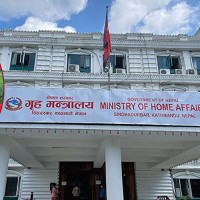- Monday, 20 October 2025
Way clears to establish new medical colleges
Kathmandu, Oct. 6: Locals of Sudurpashchim Province have been waiting for years for completion of construction of Geta Medical College (GMC) in Kailali district as it would operate a 600-bed hospital. As the construction is now almost complete, locals have something more to celebrate.
During his visit to the proposed GMC’s construction site in February 2023, Prime Minister Pushpa Kamal Dahal ‘Prachanda’ said that the GMC would be promoted as a pride project and be operated not only as a medical college but as a medical university.
Eight months later, the final process to upgrade the GMC as a university is underway. It has been confirmed after the Cabinet meeting on Tuesday decided to table the Bill on Shahid Dasharath Chand Health Science University (SDCHSU) through the Ministry of Education, Science and Technology (MoEST) at the parliament.
“The proposed Geta Medical College is now Shahid Dasharath Chand Health Science University. The Bill will be tabled at the earliest after completing some formalities,” said Shiva Kumar Sapkota, spokesperson for the MoEST.
The government had been planning to establish a designated medical university to improve medical education sector of the country. Section 46 of the National Medical Education Act states that the state will establish and operate a medical university to provide medical education.
According to medical education experts, the step will pave the way to grant affiliation to more medical colleges, both private and government, as the establishment of new medical colleges had come to a halt after the National Medical Education Act, 2018, came into force.
A study conducted by the Medical Education Commission (MEC) regarding the current situation and future demand for health workers in Nepal, showed a gap of 63,226 health workers until 2020/21. As per the study, until 2020/21, 256,597 health workers were produced in Nepal and 211,977 of them were providing services in the country. However, the demand stood at 275,203.
Moreover, of the gap of 63,226 health workers, there was a shortage of 2,904 general medical practitioners (MBBS/BDS graduates).
“We need more medical colleges to produce more doctors. However, there are no universities capable of granting affiliation to any new medical college. The establishment of the SDCHSU will ascertain affiliation to five new medical colleges in the near future,” said Dr. Anjani Kumar Jha, vice-chairman of the MEC.
As per the MEC, 1,925 seats have been allocated in 21 colleges and academies for MBBS and 545 seats for BDS in 14 colleges and academies for the academic session 2023/24.
Section 13 of the National Medical Education Act bars a university from granting affiliation to more than five medical colleges. In Nepal, Tribhuvan University and Kathmandu University alone are eligible to grant affiliation to medical colleges and have already granted affiliation to more than five medical colleges before the Act came into effect.
“If a new university wants to begin medical courses (MBBS and BDS), it should have at least a 300-bed hospital and operate it for three years. However, necessary inspection will be made before the university is granted permission to provide medical education and affiliation,” said Dr. Jha.
MoEST spokesperson Sapkota informed that the SDCHSU will start operating the 600-bed hospital after the Bill is endorsed by the parliament and necessary appointments are made.
While SDCHSU is expected to operate successfully for three years and fulfil the standards to operate as a medical university, Purbanchal University (PU) is also expected to complete the necessary standards.
“The Cabinet, in February 2023, had decided to allow PU to utilise the Biratnagar-based Koshi Hospital as its teaching hospital. Within three years, PU is expected to start its own medical classes and grant affiliation to five new medical colleges as necessary,” said Dr. Jha.
According to the Health Ministry officials, the government was under pressure to operate under-construction state-owned medical institutions as health academies in lack of a university to grant affiliation.
However, operating a state institution as an academy would require more officials and staff and increase the economic burden.






-original-thumb.jpg)










